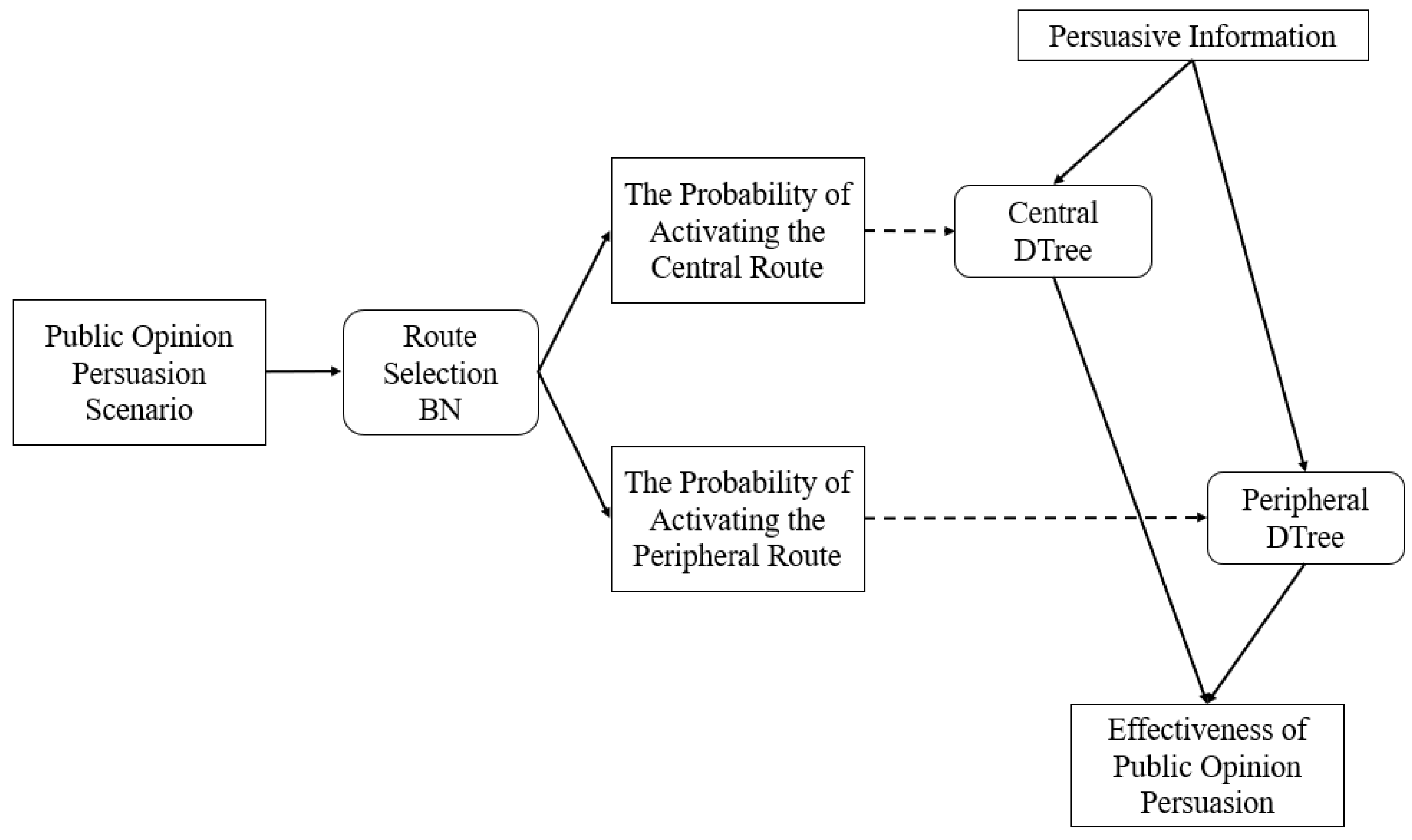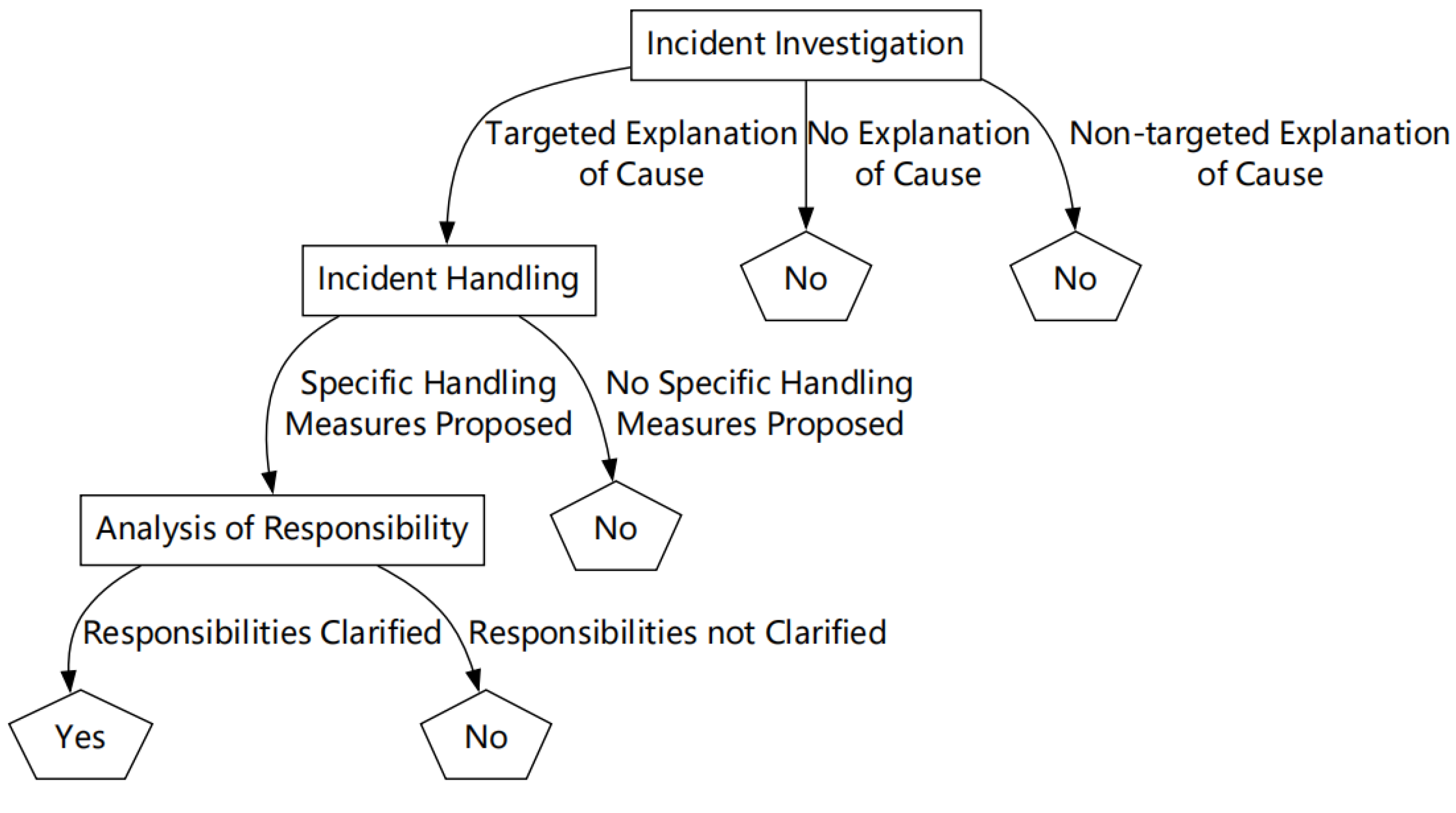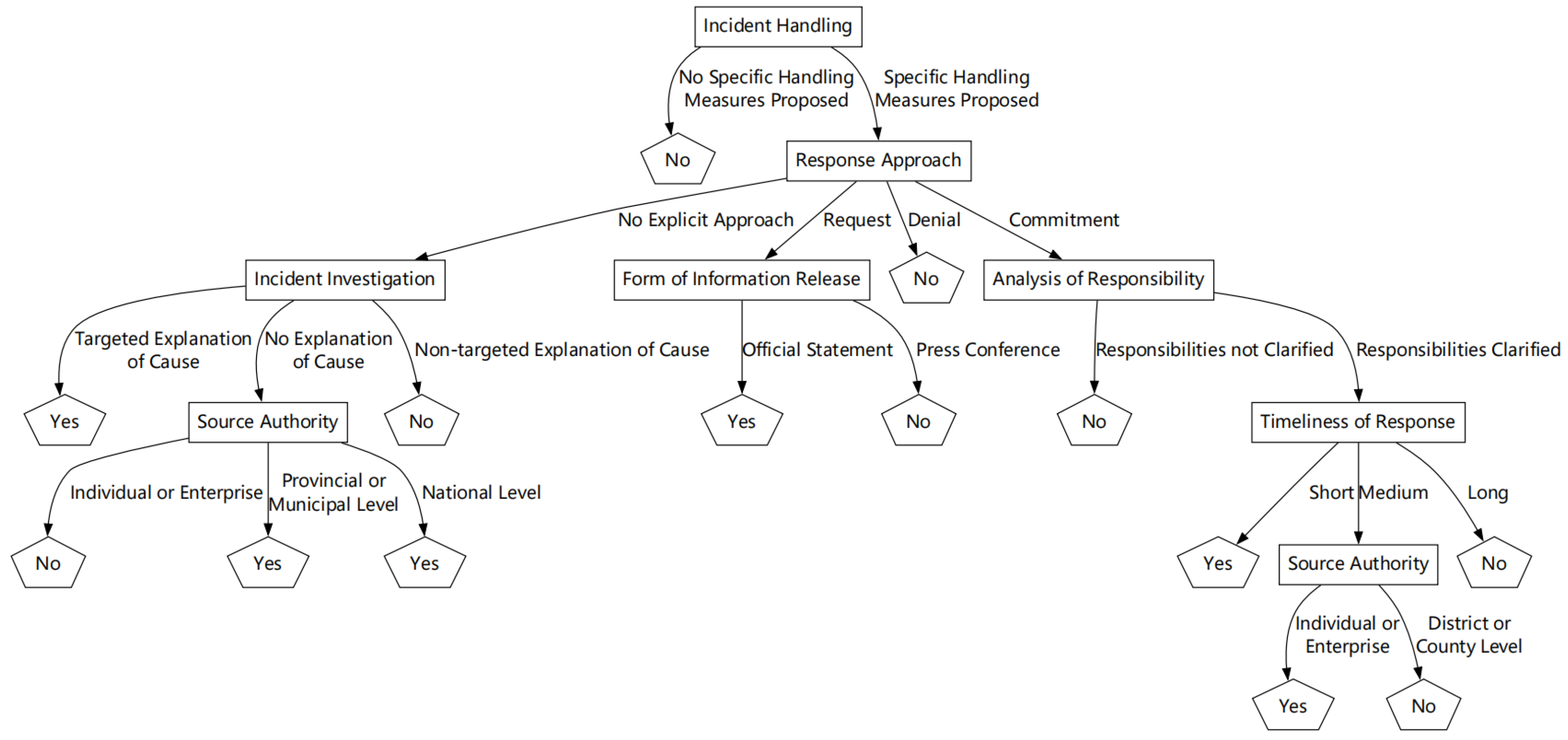In this study, our objective is not only to predict the persuasion effect, but also to provide transparent and theory-driven explanations consistent with the ELM. To achieve this, a real-world persuasive communication dataset is constructed to train the model and validate its performance. The data are obtained from social media platforms and third-party platforms, such as Weibo and “Zhiweidata”. Then, we propose the BNTree algorithm, which offers clear interpretability and theoretical mapping.
3.1. Research Framework Based on the ELM
Netizens, when confronted with different scenarios, often adopt various cognitive routes and modes of thinking to analyze official responses, leading to diverse interpretations of persuasive messages. It is essential for the analytical framework to take into account both these differences and the specific factors affecting persuasion effectiveness under different cognitive routes.
The elaboration likelihood model (ELM) provides a robust theoretical foundation for constructing such a framework. This study divides the cognitive process into two parts: the cognitive route selection process and the persuasive information attention process. The cognitive route selection process explains the reasons why netizens choose different routes, and the persuasive information attention process explains the reasons why netizens are persuaded. The following parts analyze each of these processes in detail.
The cognitive route selection process refers to the process by which netizens tend to choose a particular cognitive route under different public opinion persuasion scenarios. Specifically, when netizens possess both cognitive motivation and ability, they are more likely to activate the central route; conversely, when these are lacking, they tend to activate the peripheral route. Therefore, this study adopts four variables to measure public opinion persuasion scenarios, including the public opinion trigger, public opinion heat, recent response situation, and disclosure stage. These variables serve as the factors influencing the outcome of cognitive route selection.
The persuasive information attention process refers to the process in which netizens, under different cognitive routes, tend to focus on different aspects of persuasive information, thereby forming distinct views and attitudes. Specifically, netizens following the central route tend to focus on core information, while those following the peripheral route are more likely to focus on peripheral cues. Accordingly, this study adopts three kinds of variables: information quality (measured by incident investigation, incident handling, and analysis of responsibility), source credibility (measured by source authority and form of information release), and attitude of the response (measured by timeliness of response and response approach). These variables measure the persuasive information contained in official responses, aiming to explore the combinations of persuasive information that netizens on different cognitive routes pay attention to and the persuasive effects of these combinations on public opinion persuasion.
According to the above analysis, the data framework can be established. The database will be constructed according to the framework outlined in
Table 1.
3.2. Data Collection and Database Construction
The database is important, contains a large number of public opinion persuasion cases, and serves as the foundation for analyzing the cognitive characteristics of netizens and studying the mechanisms by which various factors influence the effectiveness of public opinion persuasion. In this study, original data are collected from channels such as “Zhiweidata” and Weibo. Among them, “Zhiweidata” is the critical data resource, which is a well-known public opinion analysis platform, and integrates data from multiple social media platforms, including Weibo and WeChat [
32]. The data from “Zhiweidata” are widely used in public opinion research [
33].
In total, 133 samples from 2020 to 2024 are collected in this study, covering variables such as public opinion persuasion scenarios, official responses, and public feedback. The variables are observable from social media platforms and third-party platforms. Moreover, some of them are controllable and can be directly adjusted by the organizations.
The samples in the database encompass a variety of types, such as livelihood issues, emergencies, improper responses from management departments, and corporate or celebrity scandals, which increased the likelihood that the sample would reflect different persuasion scenarios. In addition, as for the size of the dataset, similarly sized datasets have also been used in other studies [
34].
Based on the framework in
Table 1, this study established formalization standards for the database. Through these standards, valuable information is extracted from the original data, leading to the final construction of the public opinion persuasion database. The following section will introduce the formalization standards.
- (1)
Public Opinion Persuasion Scenario
Variable 1: Public opinion trigger refers to sudden events that draw widespread attention and discussion among netizens. These types of events influence netizens’ behaviors and attitudes. For example, when a public opinion trigger is closely related to the vital interests and actual needs of netizens, they are more likely to develop strong cognitive motivation and thus be willing to invest more effort into analyzing and considering the substantive content. On the contrary, if the trigger has little direct impact on their interests, netizens’ motivation to participate may decrease, and they will be more likely to focus on the peripheral cues [
35]. The value criteria are shown in
Table 2.
Variable 2: Public opinion heat refers to the level of discussion among netizens regarding topics related to sudden events. This variable provides a direct measure of the attention and participation of netizens. In this study, public opinion heat is reflected by the heat data collected from the “Zhiweidata” on the day before the official response is released by the persuader. If the heat data indicate 0, meaning no relevant public opinion heat was detected, it indicates that the event has not yet triggered any significant discussion among netizens, and thus, the public opinion heat is considered low. If the heat data are greater than 0 but not more than 1000, this suggests that the event has already attracted some discussion among netizens, so the public opinion heat is considered medium. If the heat data exceed 1000, it means that the event has already triggered widespread discussion among netizens, and the public opinion heat is considered high. The value criteria are shown in
Table 3.
Variable 3: Recent response situation refers to how persuaders have responded to sudden events before the official response is released. During the process of public opinion persuasion, netizens often raise questions and demands, hoping for clarification and answers from the persuaders. Therefore, the way persuaders respond can influence the cognitive ability and motivation of the netizen group. For example, when the recent response is inappropriate, it may stimulate netizens’ motivation to seek the truth. The value criteria are shown in
Table 4.
Variable 4: Disclosure stage refers to the stage at which information about the sudden incident is released on social media. Incident disclosure usually proceeds through three stages, including initial, updating, and finish stages. It can be observed that in different disclosure stages, the information about the incident varies and affects the cognitive ability and cognitive motivation of netizens. The value criteria are shown in
Table 5.
- (2)
Result of cognitive route selection
In the process of public opinion persuasion, netizens post comments and provide feedback on official responses. These comments often express the netizens’ attitudes toward the official response as well as the cognitive processes involved in forming these attitudes. Therefore, by analyzing and summarizing the semantic information contained in these comments, it is possible to extract the cognitive routes that netizens are inclined to choose. Taking the Chengdu No. 49 Middle School student’s fall as an example, in May 2021, a student in Chengdu, China, fell from a building and unfortunately died. Many netizens discussed the incident online, and one netizen commented, “This announcement is obviously unconvincing; it does not even include the timing of the incident.” It is evident that this netizen is concerned with the core information about the timing of the event in the response, indicating a tendency to activate the central route in the cognitive process. Through the analysis of a large number of comments, the criteria for determining the result of cognitive route selection are established. The value criteria are shown in
Table 6.
Based on the criteria above, this study selects the top 50 most-liked comments under the response. The top 50 comments are identified as having the highest popularity and considered reflective of prevailing public opinion. This sampling strategy is employed to prioritize comments deemed most relevant for the study of persuasion in real-world conversational settings. Each comment is annotated according to the value criteria; comments that do not meet these criteria are excluded. Finally, the cognitive path with the highest frequency in the filtered results is determined as the one that netizens are most inclined to activate. The rationale for focusing on the most-liked comments is also based on the premise that large-scale public opinion crises impacting organizational reputation, brand image, and management decisions are typically shaped by majority or consensus-driven sentiment.
- (3)
Persuasive Information
Variable 1: Information quality refers to the quality of persuasive information in terms of completeness, accuracy, and logicality [
36]. Information quality has been extensively studied due to its persuasive effect [
37,
38]. This study adopts three variables as key indicators for measuring information quality, including incident investigation, incident handling, and analysis of responsibility. The value criteria are listed in
Table 7.
Variable 2: Source credibility refers to the level of competence and trustworthiness of the persuader as perceived by netizens [
39,
40]. According to existing research [
41], the source authority is still a key factor influencing information communication. Moreover, Li et al. [
42] use online voting as a representation of source credibility, suggesting that source credibility is important for patients when considering whether to adopt online consultation services. This study measures source credibility through two variables: source authority and form of information release. The value criteria are listed in
Table 8.
Variable 3: Attitude of the response refers to the attitudes conveyed by the persuader to the netizens in official responses. Lee et al. [
43] point out that the style and attitude of official responses are important factors when persuading netizens. According to the situational crisis communication theory proposed by Coombs [
44], crisis response approaches can be divided into denial, diminish, and rebuild. Based on these findings, this study measures the attitude of the response in terms of the timeliness of response and the response approach. The value criteria are listed in
Table 9.
- (4)
Effectiveness of Public Opinion Persuasion
The effectiveness of public opinion persuasion refers to whether the persuader can effectively guide and persuade netizens to improve their views and attitudes toward the persuader. Comments embody the perspectives and attitudes of netizens. By analyzing the semantic features of these comments, it is possible to establish the value criteria in
Table 10.
To determine the effectiveness of public opinion persuasion, this study also selects the top 50 most-liked comments under the response. This sampling strategy mirrors the approach used in the process of annotating the cognitive route. Each comment is annotated according to the value criteria; comments that do not meet these criteria are excluded. Finally, the persuasion result with the highest frequency in the filtered results is determined to have the highest effectiveness in public opinion persuasion.
3.3. Development of BNTree
Based on the ELM, this study constructs an interpretable machine learning model to uncover the cognitive characteristics of netizens contained in the database. The model needs to analyze the mechanisms by which various factors influence the effectiveness of public opinion persuasion. These findings enable accurate predictions and provide persuasive decision support for persuaders to improve official responses in a targeted manner.
During the process of public opinion persuasion, netizens tend to choose different cognitive routes under various scenarios to process and analyze official responses, thereby forming corresponding views and attitudes. This process involves both cognitive route selection and persuasive information attention.
In the process of cognitive route selection, netizens do not make decisions based on hard rules but rather exhibit varying tendencies toward different routes. As a machine learning model based on probabilistic reasoning, a Bayesian Network is able to convert the uncertainty in the cognitive route selection process into probability values for uncertainty reasoning, thereby enabling the extraction of accurate and effective information from the database. Therefore, this study adopts the Bayesian Network to mine the characteristics of cognitive route selection.
In the process of persuasive information attention, netizens following different cognitive routes pay attention to different persuasive information, which may lead to the formation of distinct views and attitudes. For persuaders, a machine learning model needs not only to predict the persuasive effectiveness of responses, but also to identify the key factors influencing persuasion outcomes. Compared to machine learning algorithms such as neural networks and random forests, the decision tree offers strong interpretability, providing both predictive results and their corresponding rationales. Accordingly, this study employs the decision tree to mine the characteristics of persuasive information attention.
Based on the above analysis, this study integrates the Bayesian Network and the Decision Tree to construct the BNTree model. The framework of BNTree is shown in
Figure 1.
The algorithm process of the BNTree is shown below.
Procedure 1: Calculate the conditional probability that netizens activate different cognitive routes. The input is a variable list for public opinion persuasion scenarios, denoted as , where r1 represents the value of the public opinion trigger, r2 represents the value of public opinion heat, r3 represents the recent response situation, and r4 represents the disclosure stage. By employing the Route Selection Bayesian Network, the probability of activating the central route and activating the peripheral route is calculated, denoted as and ;
Procedure 2: Calculate the persuasion effect on netizens under different cognitive routes. The input is a variable list of persuasive information, denoted as , where is composed of a variable list of information quality , a variable list of source credibility , and a variable list of the attitude of the response . By employing the Central Decision Tree, the persuasion effect on netizens who activate the central route is calculated, denoted as . By employing the Peripheral Decision Tree, the persuasion effect on netizens who activate the peripheral route is calculated, denoted as ;
Procedure 3: Calculate the persuasion effect. The formula is as follows:
Procedure 4: Determine whether the netizens are persuaded by the response. The criterion is as follows: when , the netizens are considered to be persuaded; when , the netizens are considered not to be persuaded.
Then, the following part presents the Route Selection BN, the Central DTree, and the Peripheral DTree included in the framework.
Constructing the Route Selection BN requires specifying the network structure. By analyzing the relationships between each factor and the result of cognitive route selection, the network structure is established, which is shown in
Figure 2.
Both the Central DTree and the Peripheral DTree utilize the ID3 decision tree, employing entropy as the criterion for node splitting. They are, respectively, trained on the database where netizens activate the central route and the peripheral route. Through this process, the persuasive information attention characteristics of netizens under different cognitive routes are summarized.
It is obvious that BNTree enables direct correspondence between ELM’s psychological constructs and algorithmic structure, allowing for clear tracing of cognitive routes and influential factors. This theoretical alignment and transparency are essential for both research explanation and practical decision support in public opinion management.













